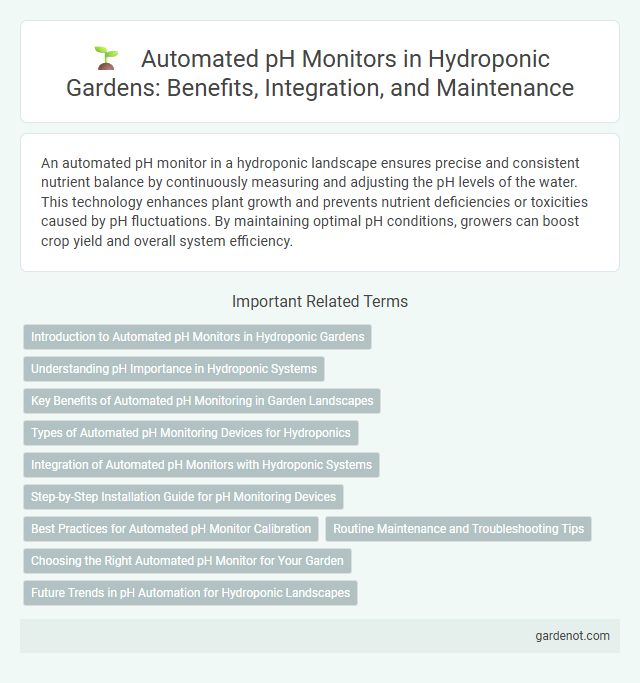An automated pH monitor in a hydroponic landscape ensures precise and consistent nutrient balance by continuously measuring and adjusting the pH levels of the water. This technology enhances plant growth and prevents nutrient deficiencies or toxicities caused by pH fluctuations. By maintaining optimal pH conditions, growers can boost crop yield and overall system efficiency.
Introduction to Automated pH Monitors in Hydroponic Gardens
Automated pH monitors in hydroponic gardens continuously measure and adjust the nutrient solution's acidity to maintain optimal plant growth conditions. These devices utilize advanced sensors and real-time data analytics to provide precise pH regulation, reducing manual intervention and minimizing nutrient imbalances. Integrating automated pH monitoring systems enhances crop yields, promotes healthier root development, and ensures consistent environmental control in hydroponic landscapes.
Understanding pH Importance in Hydroponic Systems
Maintaining optimal pH levels between 5.5 and 6.5 is crucial for nutrient absorption and plant health in hydroponic systems. Automated pH monitors provide real-time data that ensure stability, preventing nutrient lockout and promoting consistent growth. Precise pH management enhances yield quality and reduces the risk of plant stress or disease.
Key Benefits of Automated pH Monitoring in Garden Landscapes
Automated pH monitoring in garden landscapes ensures precise control of soil acidity, promoting optimal nutrient availability for hydroponic plants. This technology reduces manual labor and human error by providing real-time pH adjustments, enhancing plant health and growth consistency. Continuous pH regulation decreases the risk of nutrient deficiencies and toxicities, leading to higher yields and more vibrant garden landscapes.
Types of Automated pH Monitoring Devices for Hydroponics
Automated pH monitoring devices for hydroponics include electrode-based sensors, optical pH sensors, and solid-state pH sensors, each designed to ensure precise nutrient solution management. Electrode-based sensors, often glass or ISFET types, provide real-time pH readings with high accuracy and require regular calibration. Optical pH sensors utilize fluorescence or absorbance changes to detect pH without direct contact, minimizing maintenance and extending sensor lifespan in hydroponic systems.
Integration of Automated pH Monitors with Hydroponic Systems
Automated pH monitors seamlessly integrate with hydroponic systems through real-time data collection and precise pH adjustment, ensuring optimal nutrient absorption and plant growth. These monitors utilize sensors connected to controllers that adjust nutrient solutions automatically, minimizing human error and time-intensive manual testing. Integration with IoT platforms enables remote monitoring and alerts, enhancing efficiency and maintaining ideal pH levels within the critical 5.5 to 6.5 range for most hydroponic crops.
Step-by-Step Installation Guide for pH Monitoring Devices
Installing an automated pH monitor in a hydroponic landscape involves mounting the sensor probe securely in the nutrient solution reservoir, ensuring it is fully submerged for accurate readings. Connect the pH monitor to the control unit and power source, then calibrate the device using standard buffer solutions at pH 4.0, 7.0, and 10.0 to maintain precise pH control. Regular maintenance includes rinsing the probe with distilled water and replacing it based on manufacturer guidelines to ensure consistent nutrient balance and optimal plant growth.
Best Practices for Automated pH Monitor Calibration
Regular calibration of automated pH monitors in hydroponic landscapes ensures accurate nutrient solution readings, preventing imbalances that can affect plant growth. Best practices include using fresh pH calibration buffers at standard values of 4.00, 7.00, and 10.00, and performing calibration in a stable temperature environment to minimize sensor drift. Consistent cleaning of sensor probes and timely recalibration based on manufacturer guidelines optimize monitoring precision and enhance overall crop health.
Routine Maintenance and Troubleshooting Tips
Automated pH monitors in hydroponic landscapes require routine maintenance such as regular calibration using standard buffer solutions and cleaning of electrodes to prevent biofilm buildup and ensure accurate readings. Troubleshooting common issues involves checking for sensor drift, verifying proper electrode immersion depth, and replacing worn or damaged probes promptly. Consistent monitoring and timely maintenance extend equipment lifespan and optimize nutrient solution pH stability critical for plant health.
Choosing the Right Automated pH Monitor for Your Garden
Selecting the ideal automated pH monitor for a hydroponic garden depends on factors like sensor accuracy, calibration ease, and real-time data capabilities. High-precision probes with automatic temperature compensation ensure optimal nutrient solution balance, vital for plant growth and yield. Integration with digital control systems provides seamless pH adjustments, enhancing overall hydroponic landscape management.
Future Trends in pH Automation for Hydroponic Landscapes
Automated pH monitors in hydroponic landscapes are set to integrate advanced AI algorithms that enable real-time adjustments and predictive analytics for nutrient balancing. Future trends emphasize wireless sensor networks paired with IoT connectivity, allowing seamless remote monitoring and control through mobile applications. Enhanced accuracy and self-calibration features will drive more sustainable water and nutrient management, optimizing plant growth and yield in hydroponic systems.
Automated pH monitor Infographic

 gardenot.com
gardenot.com